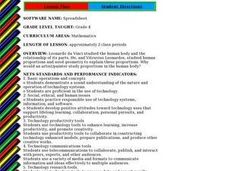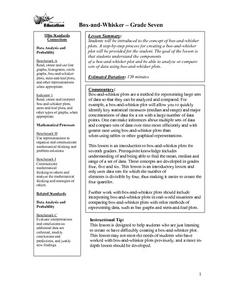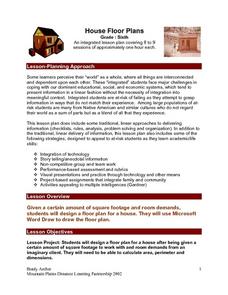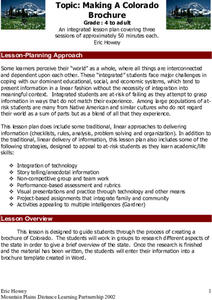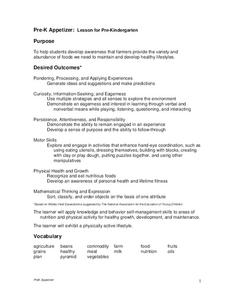Curated OER
Welcome to Venice
Students read the opening scene of the play, The Merchant of Venice without receiving any background information. They analyze and discuss the relationships between the six characters, and determine the social status of the characters.
Curated OER
Manners Matter
Students demonstrate proper behavior in the classroom and in other social situations. They write journal entries, create posters, invitations, and or multimedia presentations depiciting good manners. Pupils pair up with another students...
Curated OER
Digestion - Part 3
Learners explore the human body by reviewing the digestive system. In this human anatomy instructional activity, students identify the elements of human digestion by completing two body system worksheets. Learners read the story What...
Curated OER
Could You Repeat That?
Students participate in an oral story telling activity designed to show how story embellishments occur. They read "Beowulf" and identify incongruities that suggest additions and embellishments over the years.
Curated OER
The Underground Railroad in the I and M Canal Area
Students discuss provocative statements about the Underground Railroad and form opinions. They locate and read a selection on the Internet that either supports of discredits their written opinions. They then read a speech by John Hossack.
Curated OER
Body Proportion
Fourth graders measure the height and arm span of various classmates. They use a spreadsheet to design a graph that shows the class measurements from tallest to shortest in metric and standard systems.
Curated OER
Let's Take a Trip!
Sixth graders plan trip for family of four, and choose best travel plan by studying maps, considering different routes, and visiting Web sites to get airline and travel schedules.
Curated OER
Linear Patterns in Data
Eighth graders extend their learning of graphing linear equations and are introduced to connecting patterns in tables and graphs to represent algebraic representations. They then determine patterns and extrapolate information from these...
Curated OER
Box-and-Whisker
Seventh graders are introduced to the concept of box-and-whisker plots. A step-by-step process for creating a box-and-whisker plot is provided. The goal of the lesson is that students study the components of a box-and-whisker plot and be...
Curated OER
Discovering the Local Community
Third graders create a mini-atlas of the human and physical characteristics of their local community, which includes landforms, climate, vegetation, population, and economics. They use nonfiction map-related resources to obtain ...
Curated OER
House Floor Plans
Sixth graders investigate the mathematical concept of area. They are given a certain square footage and asked to draw the initial floorplan for a house. Students use computers to create the plan. To finish the drawing it must include the...
Curated OER
Making A Colorado Brochure
Students create a Colorado brochure. Given a variety of brochures, students explore the aspects of an attractive brochure. In groups, students explore tourist attractions, important people, major cities, and statistics of Colorado. ...
Curated OER
Case of the Missing Cookies
Students imagine they are a detective who has been asked to solve the theft of cookies from a jar in the student cafeteria. Students practice using the steps of the scientific method to solve the crime. Finally, students write a detailed...
Orange County Department of Education
Integrity and a Boy Called Slow
Fifth graders identify the character trait of integrity in the main character, Slow, in "A Boy Called Slow." They participate in a discussion to determine what steps the main character took to earn his new name. Students write an essay...
Curated OER
Islamic Art
Young scholars examine the various forms of Islamic Art. Using the art, they identify the basic elements and research its history and style of calligraphy. They create a piece of art based on information they collected and demonstrate...
Curated OER
Babylonian Mathematics 2
Students research Babylonian mathematics. They calculate simple surd numbers. Students find the fractional form of rational numbers expressed as decimals. They work with numbers in base 60.
Curated OER
Adding and subtracting fractions: the same sized slice
Students establish a strategy for adding simple fractions. They convert improper fractions to mixed numbers and interpret drawings and storyboards.
Curated OER
Jellybean Graphs
Second graders predict and graph data based on the color of jelly beans they think are in a handful. In this prediction lesson plan, 2nd graders will predict how many of each color jellybean are in a handful. Then they graph these...
Curated OER
My Multicultural Self
Learners examine the concept of multiculturalism. In this Teaching Tolerance lesson, students consider their self concepts and world views as they participate in an activity that requires them to describe themselves as well as major...
Curated OER
Extract Your Own DNA from Cheek Cells
Students observe their own DNA. In this DNA lesson, students learn the simple method of DNA extraction and explain why DNA extraction is important to scientists.
Curated OER
Strawberry DNA extraction
Students study the basic function of DNA and then extract it from strawberries. In this DNA extraction lesson students examine DNA and see why the extraction of it is so important to scientists.
Curated OER
Numbers as Descriptors
Students use numbers as descriptors. For this mathematical inquiry lesson, students use numbers to describe, classify, and compare plants. Students are made aware that numbers can be used to describe things in the world around them.
Curated OER
What About Us? Women in the Civil War
Students research the role of women in the Civil War. In this Civil War unit, students research the role women played during the war. This unit includes eight different activities including vocabulary, writing prompts and a literature...
Curated OER
Pre-K Appetizer
Students understand there are healthy and not healthy food choices. In this food pyramid lesson plan, students learn to make healthy choices by playing a traffic light game. Students recognize raw foods from the farm may not be ready for...







